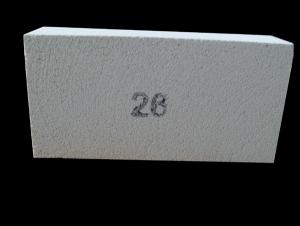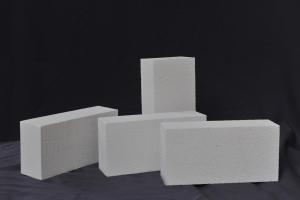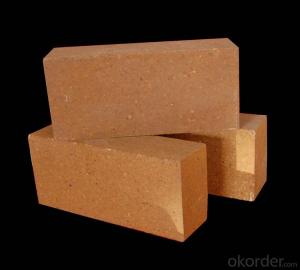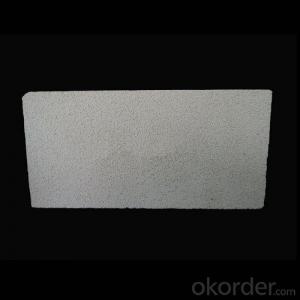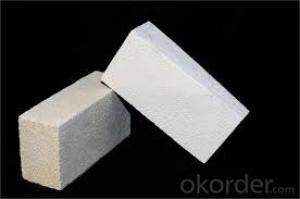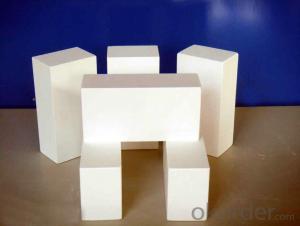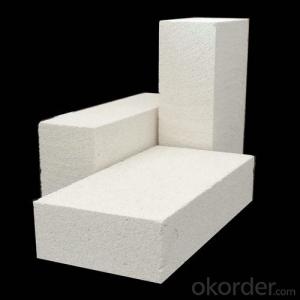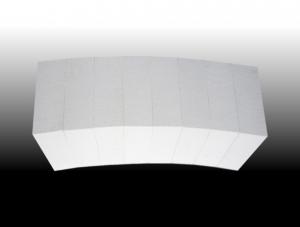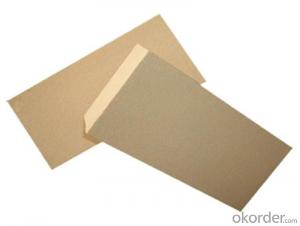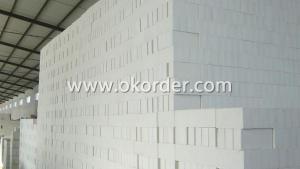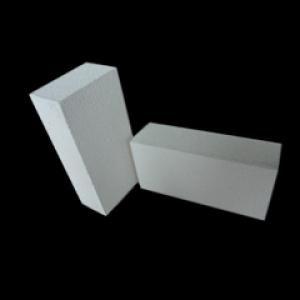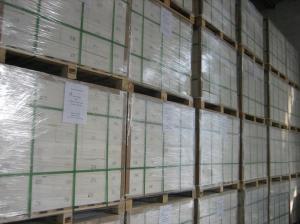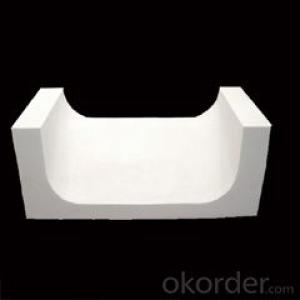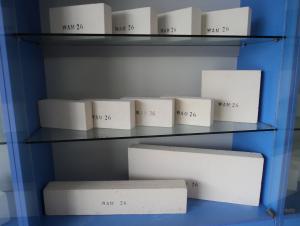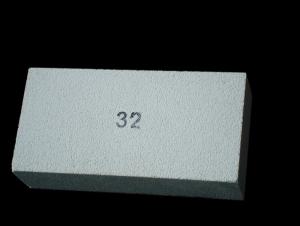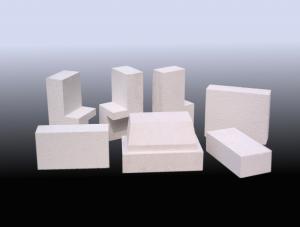Insulating Fire Brick - GJM26
- Loading Port:
- China Main Port
- Payment Terms:
- TT or L/C
- Min Order Qty:
- 1000 pcs pc
- Supply Capability:
- 1000 Tons Per Month pc/month
OKorder Service Pledge
OKorder Financial Service
You Might Also Like
General Information of Insulating Fire Brick GJM26
Insulating fire brick GJM26 are produced by high purity alumina and low iron raw materials. A viariety of
To make our firebricks more energy and cost effective, we have different manufacturing methods for our insulating fire bricks casting and extruding method.
For insulating fire bricks GJM28,we choose the extruding method. Extruding insulating fire bricks have better strength and offering great performance in load bearing applications and in conditions where abrasion from mechanical abuse or flow of hot gases.
Characteristics of Insulating Fire Brick GJM26
Our insulating fire bricks exhibit the following characteristics:
Light weight and low thermal conductivity allows thinner furnace walls
Low heat storage results in rapid cooling and heating operation
Low iron and impurities to enhance reducing atmosphere
Technical Data of Insulating fire bricks
|
| JM26 |
Physical Properties: |
|
|
Classifiction Temperature | ℃ | 1430.0 |
Density | Kg/m3 | 850.0 |
Cold Crushing Strength | Mpa | 2.0 |
Reheating Linear Change(24hrs) |
|
|
1400℃ | % | 0.5 |
Hot Load Strength Deform(90 minutes) |
|
|
1260℃ at 0.069 Mpa(10psi) | % | 0.2 |
Thermal Conductivity |
|
|
400℃ | W/m.k | 0.3 |
600℃ | W/m.k | 0.3 |
800℃ | W/m.k | 0.3 |
1000℃ | W/m.k | 0.3 |
1200℃ | W/m.k | 0.4 |
Specific Heat | KJ/Kg.K | 1.1 |
Chemical Analysis: |
|
|
Al2O3 | % | 50.0 |
SiO2 | % | 47.1 |
Fe2O3 | % | 0.7 |
TiO2 | % | 0.1 |
CaO | % | 0.1 |
MgO | % | 0.2 |
Na2O+K2O | % | 1.7 |
Typical Application of Insulating fire bricks
Ceramic shuttle kilns
Oil refinery heaters
Laboratory furnaces
Backup insulation for all furnaces
We has success in insulating fire bricks due to their cost-effectiveness, excellent insulation properties. CNBM also has experience in insulating fire bricks application and would like to assist you in product selection, system design, and installation techniques.
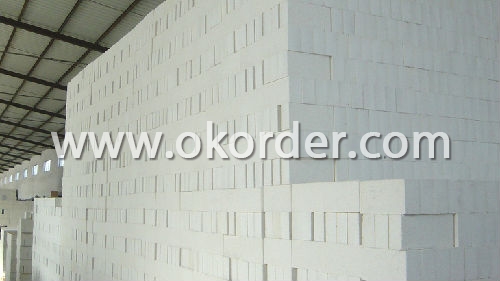
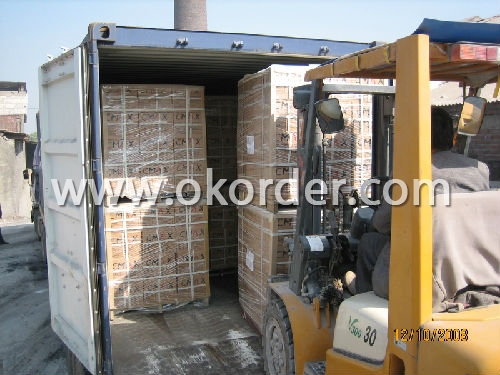
- Q: Can insulating fire bricks be used in refractory lining for steelmaking?
- Insulating fire bricks can indeed be utilized for refractory lining in the steelmaking industry. Crafted from lightweight ceramic materials, these bricks possess remarkable thermal insulation properties. Consequently, they prove to be highly suitable for applications involving elevated temperatures, such as steelmaking, where the maintenance of a consistent temperature is of utmost importance. By incorporating insulating fire bricks, heat loss can be minimized, energy efficiency can be enhanced, and insulation against the extreme temperatures encountered in steel production can be provided. Moreover, these bricks exhibit resistance to thermal shock, a vital characteristic for withstanding sudden temperature fluctuations during the steelmaking process. Consequently, the utilization of insulating fire bricks within refractory lining for steelmaking purposes can significantly optimize the performance and efficiency of the entire steelmaking operation.
- Q: Can insulating fire bricks be used in thermal oxidizers?
- Yes, insulating fire bricks can be used in thermal oxidizers. Insulating fire bricks are designed to have low thermal conductivity, meaning they can effectively reduce heat transfer and conserve energy in high-temperature applications. Thermal oxidizers are devices used to treat industrial exhaust gases by oxidizing pollutants at high temperatures. By using insulating fire bricks in the construction of thermal oxidizers, heat can be contained within the system, ensuring efficient combustion and minimizing heat loss to the surroundings. This not only improves the overall thermal efficiency of the thermal oxidizer but also helps to reduce energy consumption and operating costs. Additionally, insulating fire bricks are highly resistant to thermal shock and have excellent insulating properties, making them suitable for the harsh and demanding conditions typically found in thermal oxidizers.
- Q: Can insulating fire bricks be used as insulation in walls and roofs?
- Yes, insulating fire bricks can be used as insulation in walls and roofs. Insulating fire bricks are made from lightweight materials that have excellent thermal insulation properties. They have low thermal conductivity, which means they can effectively reduce heat transfer through walls and roofs. This makes them a suitable choice for insulating buildings and improving energy efficiency. Additionally, insulating fire bricks are durable and fire-resistant, making them a safe option for insulation. However, it is important to note that insulating fire bricks are typically used in high-temperature applications such as furnaces and kilns, so they may not be the most cost-effective or practical choice for all wall and roof insulation needs. Other insulation materials designed specifically for building applications may be more suitable in terms of cost, ease of installation, and overall performance.
- Q: Are insulating fire bricks resistant to vibration or seismic activity?
- Insulating fire bricks are generally not resistant to vibration or seismic activity. These bricks are designed to provide insulation and are therefore lightweight and porous. While they may be able to withstand minor vibrations or low levels of seismic activity, they are not specifically engineered to handle significant levels of shaking or tremors. In applications where vibration or seismic activity is a concern, it is advisable to use specially designed bricks or materials that are specifically manufactured to withstand these types of forces.
- Q: Can insulating fire bricks be used in outdoor fire pits?
- Yes, insulating fire bricks can be used in outdoor fire pits. Insulating fire bricks are designed to withstand high temperatures and provide excellent insulation, making them suitable for outdoor fire pits where heat retention and durability are important.
- Q: Can insulating fire bricks be used in chimneys and fireplaces?
- Chimneys and fireplaces can indeed utilize insulating fire bricks. These bricks are specifically crafted to endure high temperatures and offer exceptional insulation. They are constructed from lightweight materials like ceramic fibers or refractory materials, which aid in minimizing heat transfer. Thus, they are an optimal choice for lining chimneys and fireplaces since they retain heat within the firebox and prevent its escape through the chimney. Moreover, insulating fire bricks enhance the heating system's efficiency by reducing heat loss and elevating the overall heat output. However, it is crucial to emphasize that insulating fire bricks should only be employed in appropriate sections of the chimney or fireplace, such as the firebox. Conversely, the smoke chamber or flue necessitate different types of bricks capable of withstanding the corrosive effects of flue gases.
- Q: Can insulating fire bricks be used for insulation in heat exchangers?
- Yes, insulating fire bricks can be used for insulation in heat exchangers. Insulating fire bricks have excellent thermal properties, high insulation efficiency, and can withstand high temperatures, making them suitable for heat exchangers where insulation is crucial to minimize heat loss and increase energy efficiency.
- Q: Can insulating fire bricks be used in biomass boilers?
- Yes, insulating fire bricks can be used in biomass boilers. These bricks are designed to withstand high temperatures and provide excellent insulation, making them suitable for use in biomass boilers where heat retention is crucial for efficient combustion.
- Q: Are insulating fire bricks resistant to molten metals?
- Insulating fire bricks, in general, exhibit resistance to molten metals. These bricks are composed of refractory materials with high melting points and exceptional thermal insulation properties, rendering them appropriate for high-temperature scenarios involving molten metals. The insulation capabilities of these bricks serve to curtail heat transfer, thereby preventing the conduction of heat from the molten metal through the brick. Furthermore, the refractory materials employed in these bricks possess minimal thermal expansion, enabling them to endure the thermal shock that may arise upon contact with molten metals. However, it is important to acknowledge that the resistance of insulating fire bricks to molten metals may vary based on factors such as metal type, temperature, and duration of exposure. Hence, it is advisable to consult the manufacturer or a professional to ascertain the suitability of insulating fire bricks for the specific application involving molten metals.
- Q: Do insulating fire bricks have a high electrical resistivity?
- Yes, insulating fire bricks generally have a high electrical resistivity. This is because these bricks are specifically designed to have low thermal conductivity and high thermal resistance, which also translates into high electrical resistivity. The insulating materials used in these bricks, such as alumina, silica, and other refractory materials, have inherently high electrical resistivity. Additionally, the manufacturing processes often involve the addition of insulating additives, further enhancing the electrical resistivity of the fire bricks. As a result, insulating fire bricks are effective in reducing heat transfer and maintaining high temperatures in various industrial applications, such as kilns, furnaces, and thermal insulation systems.
1. Manufacturer Overview
| Location | Jiangsu, China |
| Year Established | 2008 |
| Annual Output Value | Above US$ 35 Million |
| Main Markets | Germany; Italy; Turkey; France; England; Japan; Thailand; Vietnam; Idonesia; USA |
| Company Certifications | ISO 9001:2008 |
2. Manufacturer Certificates
| a) Certification Name | |
| Range | |
| Reference | |
| Validity Period |
3. Manufacturer Capability
| a) Trade Capacity | |
| Nearest Port | Shanghai; Qingdao |
| Export Percentage | 10% |
| No.of Employees in Trade Department | 3 People |
| Language Spoken: | English; Chinese; |
| b) Factory Information | |
| Factory Size: | Twenty five thousand tons per year |
| No. of Production Lines | Above 5 |
| Contract Manufacturing | OEM Service Offered; Design Service Offered |
| Product Price Range | High; Average |
Send your message to us
Insulating Fire Brick - GJM26
- Loading Port:
- China Main Port
- Payment Terms:
- TT or L/C
- Min Order Qty:
- 1000 pcs pc
- Supply Capability:
- 1000 Tons Per Month pc/month
OKorder Service Pledge
OKorder Financial Service
Similar products
Hot products
Hot Searches
Related keywords








